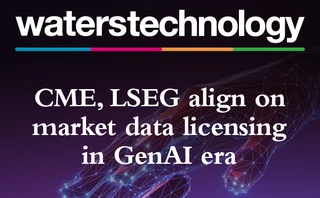Max Bowie: Are Data Clouds Virtual Reality?

This year’s Sifma show was spared the New York heat and humidity, thanks to thick cloud cover—inside the venue. Cloud was on every exhibitor’s lips as data providers are seeing the benefits of deploying services in virtual environments.
Canny vendors are exploiting the ubiquity of the “cloud” term, using it to refer loosely to any web-based service. But cloud is moving from simply a storage option to a way for firms to access more than just their own databases, and vendors and exchanges can make themselves stickier by using it to provide access to other technologies and services that complement their own. For example, NYSE Euronext announced it is making access to its markets—and other data services within its datacenters—available in a cloud model that allows firms to operate a managed co-location “cloud” in the exchange’s facilities that they can dial up or down.
Cloud has been on the radar for a while. Last year, consultant John Akbari wrote an article for Inside Market Data predicting clouds on the horizon as firms seek to expand services and cut costs. In January, a Gartner survey showed cloud and virtualization rising to CIOs’ first and second priorities for 2011, respectively. And 45 percent of respondents to a recent Bloomberg survey say cloud yielded the greatest return on investment over the past year.
Why? The perfect storm created by the financial crisis led firms to investigate lighter technologies that let them do more without adding costs—particularly smaller, buy-side firms without the resources and budgets of their larger rivals. “Small firms will almost certainly look at things they can take as a service rather than acquiring any technology to install on-premise and manage themselves. And given that they won’t likely have a massive budget for IT, much less the IT staff to support an entire on-premise infrastructure, I expect them to look to get as much as they can as a service,” says Rik Turner, senior analyst at research firm Ovum.
Thomson Reuters is seeing this trend play out, with clients moving data architectures that they previously ran on-site into the vendor’s Elektron hosting centers. This gives them proximity to markets and increased scalability, but also access to a range of other services from Thomson Reuters as well as third parties that see the benefits of being part of Elektron’s community, which the vendor is positioning as a central meeting place for clients and services, such as the over-the-counter markets more suited to peer-to-peer communication, says Jon Robson, president of the vendor’s Enterprise division.
“Once connected to Elektron, clients can use their Enterprise Platform for Real-Time implementation as satellite nodes on the network to become publishers and receivers of services across the cloud. Any service available in the cloud can be run and permissioned using those local installations. This allows an entire ecosystem of connections between trading platforms, service providers, counterparties and intermediaries to cross-connect inside the global market fabric of Elektron,” Robson says. “Over time there will be thousands of points of presence around the world hooking into our Elektron cloud. The financial community will be able to wire itself together through simple connections in the cloud.”
As Stanley Young, CEO of NYSE Technologies, puts it: “If a firm isn’t buying services like this in a year, their shareholders should be asking why not.”
Storm Brewing
One storm is still brewing: When is a cloud not a cloud? Some say many cloud solutions are just hosted services, and that it’s only truly cloud if it’s on-demand. Part of NYSE’s initiative is just that: the ability to configure the servers you want within NYSE’s datacenter, and change as needed. But there’s a difference between on-demand access and on-demand consumption, such as the offerings of web services data provider Xignite, and the exchanges that use its technology to provide access to their historical data. And there’s a difference between on-demand access to historical data and on-demand real-time data—which some in the industry see as offering administration benefits and savings through pay-as-you-go pricing. And if you can switch servers on and off at will, why not data, too?
Only users who have a paid subscription or are part of a corporate subscription are able to print or copy content.
To access these options, along with all other subscription benefits, please contact info@waterstechnology.com or view our subscription options here: https://subscriptions.waterstechnology.com/subscribe
You are currently unable to print this content. Please contact info@waterstechnology.com to find out more.
You are currently unable to copy this content. Please contact info@waterstechnology.com to find out more.
Copyright Infopro Digital Limited. All rights reserved.
As outlined in our terms and conditions, https://www.infopro-digital.com/terms-and-conditions/subscriptions/ (point 2.4), printing is limited to a single copy.
If you would like to purchase additional rights please email info@waterstechnology.com
Copyright Infopro Digital Limited. All rights reserved.
You may share this content using our article tools. As outlined in our terms and conditions, https://www.infopro-digital.com/terms-and-conditions/subscriptions/ (clause 2.4), an Authorised User may only make one copy of the materials for their own personal use. You must also comply with the restrictions in clause 2.5.
If you would like to purchase additional rights please email info@waterstechnology.com
More on Trading Tech
The next phase of AI in capital markets: from generative to agentic
A look at some of the more interesting projects involving advanced forms of AI from the past year.
Will overnight trading in equity markets expand next year? It’s complicated.
The potential for expanded overnight trading in US equity markets sparked debate this year, whether people liked it or not.
WatersTechnology latest edition
Check out our latest edition, plus more than 13 years of our best content.
The total portfolio approach gains momentum: Building the right tech foundation for success
The rationale for the TPA, and the crucial role technology plays in enabling such an approach
Google, CME say they’ve proved cloud can support HFT—now what?
After demonstrating in September that ultra-low-latency trading can be facilitated in the cloud, the exchange and tech giant are hoping to see barriers to entry come down.
Institutional priorities in multi-asset investing
Private markets, broader exposures and the race for integration
BlackRock and AccessFintech partner, LSEG collabs with OpenAI, Apex launches Pisces service, and more
The Waters Cooler: CJC launches MDC service, Centreon secures Sixth Street investment, UK bond CT update, and more in this week’s news roundup.
TCB Data-Broadhead pairing highlights challenges of market data management
Waters Wrap: The vendors are hoping that blending TCB’s reporting infrastructure with Broadhead’s DLT-backed digital contract and auditing engine will be the cure for data rights management.








